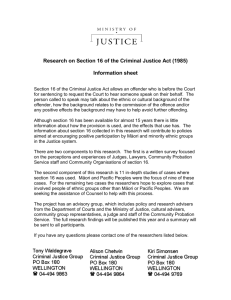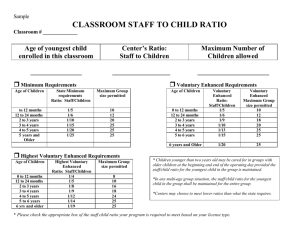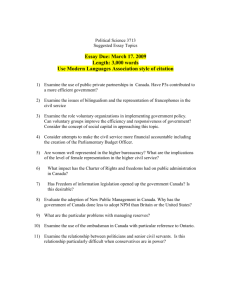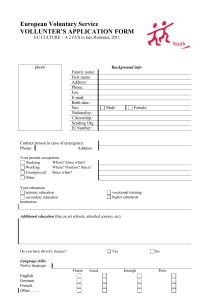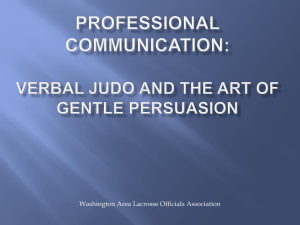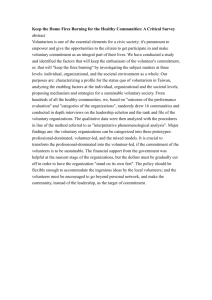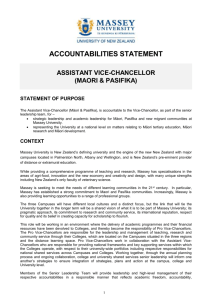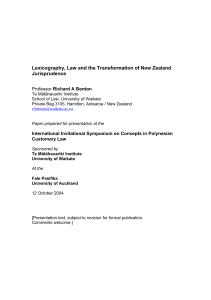social capital and voluntary activity
advertisement
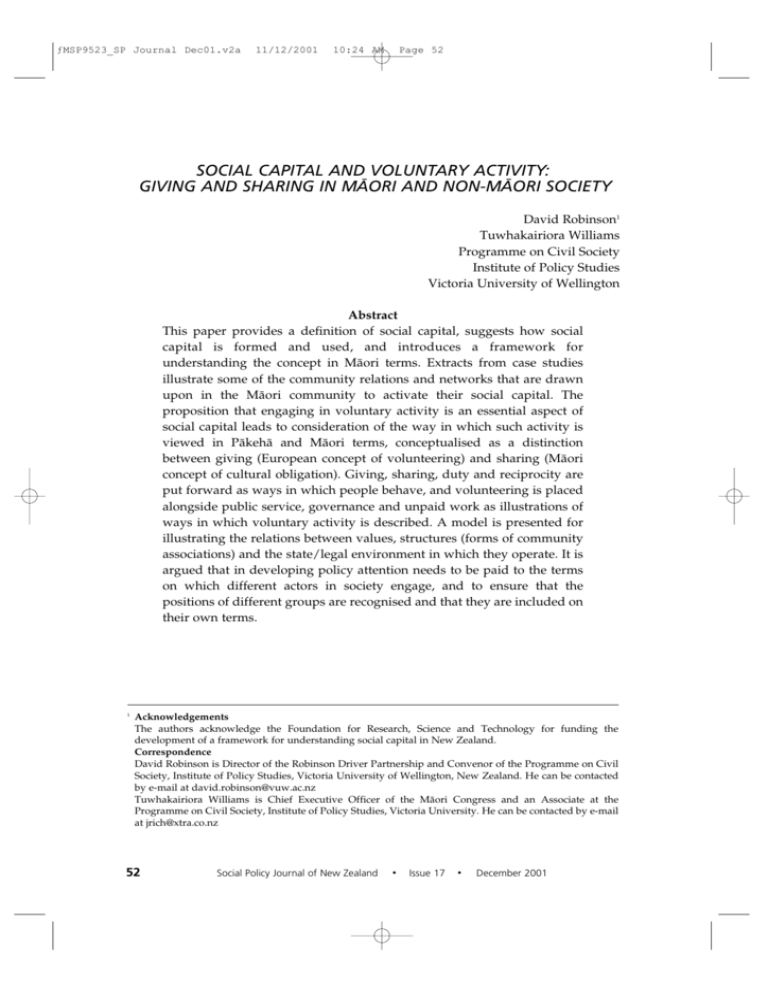
ƒMSP9523_SP Journal Dec01.v2a 11/12/2001 10:24 AM Page 52 SOCIAL CAPITAL AND VOLUNTARY ACTIVITY: GIVING AND SHARING IN MĀORI AND NON-MĀORI SOCIETY David Robinson1 Tuwhakairiora Williams Programme on Civil Society Institute of Policy Studies Victoria University of Wellington Abstract This paper provides a definition of social capital, suggests how social capital is formed and used, and introduces a framework for understanding the concept in Mäori terms. Extracts from case studies illustrate some of the community relations and networks that are drawn upon in the Mäori community to activate their social capital. The proposition that engaging in voluntary activity is an essential aspect of social capital leads to consideration of the way in which such activity is viewed in Päkehä and Mäori terms, conceptualised as a distinction between giving (European concept of volunteering) and sharing (Mäori concept of cultural obligation). Giving, sharing, duty and reciprocity are put forward as ways in which people behave, and volunteering is placed alongside public service, governance and unpaid work as illustrations of ways in which voluntary activity is described. A model is presented for illustrating the relations between values, structures (forms of community associations) and the state/legal environment in which they operate. It is argued that in developing policy attention needs to be paid to the terms on which different actors in society engage, and to ensure that the positions of different groups are recognised and that they are included on their own terms. 1 Acknowledgements The authors acknowledge the Foundation for Research, Science and Technology for funding the development of a framework for understanding social capital in New Zealand. Correspondence David Robinson is Director of the Robinson Driver Partnership and Convenor of the Programme on Civil Society, Institute of Policy Studies, Victoria University of Wellington, New Zealand. He can be contacted by e-mail at david.robinson@vuw.ac.nz Tuwhakairiora Williams is Chief Executive Officer of the Mäori Congress and an Associate at the Programme on Civil Society, Institute of Policy Studies, Victoria University. He can be contacted by e-mail at jrich@xtra.co.nz 52 Social Policy Journal of New Zealand • Issue 17 • December 2001 ƒMSP9523_SP Journal Dec01.v2a 11/12/2001 10:24 AM Page 53 Social Capital and Voluntary Activity: Giving and Sharing in Māori and Non-Māori Society INTRODUCTION This paper considers voluntary activity from Mäori and non-Mäori perspectives, within a framework that is being developed to understand social capital in New Zealand and the factors that contribute to it. In this framework we suggest that one key indicator of social capital may be the degree of “giving”, which shows the levels of commitment within a community. The overall framework that we are developing for the understanding of social capital is predicated on the assumption that the “whole story” about social capital is the story of the social setting or context in which actors give and receive. This context includes actors’ knowledge of each other’s interests and resources, the opportunities that exist for exchange (including unilateral transfers) and the inducements and disincentives associated with norms of giving. Thus to understand the nature of social capital we need to understand the rules governing direct giving, or unilateral transfers, and the rules for those exchanges that take the form of sharing, where the benefit from that giving is shared within the community to which the “giver” belongs. Our discussion explores the mix of interests, resources and norms that “generate” these actions and the fit between an activity and the environment in which it occurs. In our programme on social capital, supported by the Foundation for Research, Science and Technology, we initially focused on the value of voluntary organisations in providing spaces for the creation and expression of social capital. Subsequent discussion has led us to emphasise the behaviour (community communication and discussion) that helps create social capital and social cohesion rather than the organisational forms which best nurture it (generally presented as voluntary or nonprofit organisations). We suggest that building social capital requires: • active and knowledgeable citizens – actors; • a rich network of voluntary associations – agency; and • forums for public deliberation – opportunity. The form of social-capital-intensive relations and networks is important and thus our framework focuses on understanding the terms on which people interact. In addition to acknowledging factors such as the presence of networks of voluntary activity, we need to understand the nature of relationships within and between sectors rather than regard them as discrete arenas. All systems (organisations, communities or societies) contain the core features of social capital in so far as they operate with a set of norms and values, they have ways of sanctioning activities, and a degree of knowledge and information is available. The issue is how to release or activate this potential for collective well-being. To understand this Social Policy Journal of New Zealand • Issue 17 • December 2001 53 ƒMSP9523_SP Journal Dec01.v2a 11/12/2001 10:24 AM Page 54 David Robinson, Tuwhakairiora Williams requires understanding the rules of engagement in a system. This may suggest why some people are excluded from active participation in society while others dominate. A DEFINITION OF SOCIAL CAPITAL Social capital refers to the collection of resources to which an individual or a group has access through their membership in an ongoing network of mutual acquaintance. Features of this social structure, such as relationships, norms and social trust, help develop coordination and cooperation for common benefit. In our definition of social capital, the term “resources” includes status, attention, knowledge and opportunities to participate and communicate. It does not only refer to connections that provide access to physical resources and information. An essential feature of our definition is that social capital provides “a capacity to associate for mutual benefit or common purpose”. In investigating forms of voluntary activity we are also exploring how this “capacity to associate” is created or restricted. Social capital is often realised through involvement in forms of voluntary association, and this association provides opportunities to communicate and to ascertain the interests and mandate of others. Networks and relationships enable the flow and exchange of information; they provide “spaces” in which communication can take place. When systems are rich in social capital, access to information is widened and this enables views and knowledge to be shared. The actual nature of the resources that an individual, group or system has access to, their criteria for membership, and the form that networks take, will vary among different groups and cultures. THE PROCESS OF SOCIAL CAPITAL FORMATION In general, although social capital can be increased through investment in the actions that help create it, it does not decrease through use. Use of social capital adds to the stock through carrying out actions that are integral to its creation (networking, communication, cooperative support, etc.). In our case study of the development of a rural community’s drug treatment programme working on a Mäori kaupapa model, we have observed that there is something of a “quid pro quo” aspect to the draw-down of social capital. What has been taken has also been replaced and added to by the interaction of the parties: existing relationships are reaffirmed, new experiences are encountered and another dimension of the relationship is established. 54 Social Policy Journal of New Zealand • Issue 17 • December 2001 ƒMSP9523_SP Journal Dec01.v2a 11/12/2001 10:24 AM Page 55 Social Capital and Voluntary Activity: Giving and Sharing in Māori and Non-Māori Society However, social capital can be diminished through attitudes and behaviour that restrict access to its core aspects. That is, untrustworthy behaviour by public and private organisations, restrictions on the freedom of operation of voluntary associations, the removal or limitation of spaces for deliberation and networking, non-reciprocal relationships (such as directive, non-negotiated contracts) and not recognising the status of marginalised groups. These lead to reduced knowledge of others’ interests, limit the development of emerging norms and restrict the exchange of information. Social capital is not something that is produced and consumed without trace; it is not a transitory process. There must be some meaningful accumulated stocks of social capital resources in a community or system to justify the use of the term capital. SOCIAL CAPITAL IN A MĀORI CONTEXT In defining the core characteristics of social capital in a Mäori context, it is useful to compare this with a European perspective on social capital. Robert Putnam (2000), for example, emphasises the role of community organisations, or “networks of civic engagement”, in providing the opportunity for interaction that builds “networks, norms and trust that facilitate coordination and cooperation for mutual benefit”. Other social scientists, such as North (1990, quoted in World Bank Social Capital Initiative 1999), include functional relations and structures such as the political regime or the legal and judicial system in their definition of social capital. This approach focuses attention on networks that are created outside the family through a wide range of community associations (see Bowling Alone (Putnam 2000) for a detailed analysis of changes in participation in these forms of association in the United States) and it conceptually separates family from community. In contrast, the Mäori concept of family (whänau) moves seamlessly from the immediate family to the wider family network (hapü) and the tribe (iwi), where the (extended) family becomes the community and the community is made up of the (extended) family. Social capital is created through networks and relationships that are within all of these expressions of “family” (or community). Thus, in the Mäori context, the distinction between cultural and social capital disappears. Cultural capital is an important aspect of social capital and social capital is an expression of cultural capital in practice. Social capital is based on and grows from the norms, values, networks and ways of operating that are the core of cultural capital. A Mäori concept of social capital emphasises the following elements: • Extended family relationships are the basis for all other relationships. The whänau is the nucleus of all things. Mäori community values and norms come from traditional values that are rooted in the whänau. Social Policy Journal of New Zealand • Issue 17 • December 2001 55 ƒMSP9523_SP Journal Dec01.v2a 11/12/2001 10:24 AM Page 56 David Robinson, Tuwhakairiora Williams • It is essential to have knowledge of, and to know one’s place in, Mäori society, which is multi-dimensional, covering the geographical place to which one belongs as well as a place within the hierarchy of whänau, hapü and iwi where one belongs. • Relationships in Mäori society develop around informal association rather than formal organisations. The connectedness that is derived from this association is an intended consequence of whänau and iwi relations. The nature of this social capital may not be articulated but its value is understood. • The holistic, integrating nature of relationships and networks are of primary importance, while their use or functional activity is secondary. Family, tribal and community networks may take priority over functional contracts with specified agencies such as health, education or welfare. Membership in customary Mäori associations is based on an exchange of obligations and acceptance by the group. Conditions for joining are verbal, implicit and obligationdriven – rather than rule-driven, specified and written down as in European society. The concept of obligation-driven membership includes obligations based on a common ancestry and the cultural dimension that obliges one to act in certain ways that give rise to the development of social capital. This sense of obligation underpins a Mäori concept of voluntary activity. Key concepts of Mäori society that relate to social capital include manaaki (cultural obligation to welcome and care for visitors) and häpai (the requirement to apply the concept of uplifting/enhancement) and tautoko (providing support within the community). The assimilationist policies of the past, the economic reforms of the 1980s and 1990s, and more recently the current government’s “Closing the Gaps” agenda, all required Mäori to draw on their store of social capital in order to address the impact of these programmes and to sustain themselves in the face of the challenges that arose as a consequence of the political agenda-setting patterns of successive governments. Where Mäori have become more introverted and consolidated in their views, their social capital has become isolated and less accessible for connecting with society as a whole. However, in areas such as the arts and sport, where social capital is shared between cultures, the isolation and access issues become less apparent and participation has served a bridging function. THE MURIWAI TOURNAMENT One example of Mäori drawing on and building social capital involves the Whakatohea Iwi. In the Opotiki District, an annual sports tournament was initiated from within the tribe to encourage and celebrate excellence, enhance competition and promote a 56 Social Policy Journal of New Zealand • Issue 17 • December 2001 ƒMSP9523_SP Journal Dec01.v2a 11/12/2001 10:24 AM Page 57 Social Capital and Voluntary Activity: Giving and Sharing in Māori and Non-Māori Society healthy lifestyle. One of the most important spin-offs of the event is that it also enables the practice and application of all the traditional values and principles of whänau, hapü and iwi. The event was named the Muriwai Tournament, and it was established 15 years ago as a whänau initiative. The family very quickly realised its potential and persuaded the hapü that the event should be broadened to include the extended whänau of the Ngai Tama hapü. The hapü took up the challenge and the following year an invitation was extended to the affiliates of the hapü to form netball and rugby teams to compete in a mini-tournament. The success of that experience led the hapü to invite the other five hapü of Whakatohea to compete in a tournament the following year. What was learned from these experiences has contributed to the format of successive tournaments. Besides the benefit of promoting a healthy lifestyle through sport, the tournament provides the opportunity each year for whänau to come together and reconnect with their tribal roots. Teams are organised and compete on a hapü basis. Whänau who live outside the tribal boundary are accommodated at their respective marae. Those who travel from overseas use this as an opportunity to interact with immediate family, and fulfil tribal commitments. Organisational arrangements are the responsibility of each hapü. Family members living at “home” deal with these matters and inform the wider whänau of the details of the arrangements, and they in turn organise themselves in accordance with these arrangements. The pattern is well established and works successfully. The aim of the tournament is to provide a platform for the exercise of whanaungatanga (kinship). This concept traverses a diverse range of spiritual and physical experiences that draw on an equally diverse range of emotional responses, all of which are rooted in Mäori culture. Opportunities for the expression by Mäori people of this cultural practice in its natural environment (i.e. as a natural expression of Mäori norms and values) are very limited. This also applies to other important principles and the practice of manaakitanga and wairuatanga (spirituality). Manaakitanga (hospitability) is that state within which one accords total support, respect and dignity to one’s kinsfolk and fellow human beings and wairuatanga is the spiritual state within which these practices are intertwined. The opportunity to practise them unencumbered contributes significantly to the level of participation. Participants arrive at their respective marae on the evening before the tournament. They are welcomed in the traditional way and the evening is spent finalising teams for the two-day event as well as catching up on family news. At the end of the first day teams and families retreat to their marae to discuss whänau, hapü and iwi matters. These discussions assist everyone to connect with each other, with the heartbeat of the Social Policy Journal of New Zealand • Issue 17 • December 2001 57 ƒMSP9523_SP Journal Dec01.v2a 11/12/2001 10:24 AM Page 58 David Robinson, Tuwhakairiora Williams iwi and with the responsibility on each for the welfare and well-being of the tribal community. For many people it is their only opportunity to engage in rekindling links with their tribal heritage and responsibilities. Representation is subject to fierce competition. The mana (prestige, dignity and authority) of the hapü is at stake. As an illustration of this, teams often include members of the tribe who have excelled in these sporting codes at national and international levels. These young men and women are excellent role models and their participation allows the tribe to celebrate their achievements. Whakaiti (the practice of humbling oneself) is an important characteristic. While one’s kinsfolk will celebrate one’s achievements, it is expected that one will receive such adulation in a spirit of humility. The real prize belongs to the collective and individual achievements are part of the whole that contributes to the mana and well-being of the tribe. Individual excellence is an enhancing experience that is shared by the whänau whänui (wider family). Mäori culture is based on the concept of interdependence. Expressions of individuality and personal achievement are inextricably linked to this concept. It is the reference point of such expressions and achievements. At the completion of the formal welcome, everyone is reconnected with the ahi kaa (those who keep the home fires burning) and each person is expected to carry out the tasks associated with being on the marae. The exercise of these practices involves “civic engagement” within a Mäori cultural context where the environment is safe in its reaffirmation of the relevance and validity of the practices. “Mäori development, whether economic, political or social,” says Douglas (1997), “is group-oriented and contains a very large measure of mana motuhake (autonomy and authority), together with whanaungatanga (kinship), manaakitanga (sharing and caring) and kotahitanga (unity).” The opportunity to reconnect and to reflect in this way is as much a reason for participating in the tournament, as is the opportunity to compete in the event. The labour is entirely voluntary and people opt to take responsibility for the various tasks. Meetings are held on a regular basis and the day before the event all the workers meet at the marae to report on progress and attend to last minute details. Food preparations for the various stalls are finalised. The preparations are done at the marae and everyone contributes to this task. During the preparations one year, one of the families received a message that an aunt had passed away and was lying in state at a nearby marae. 58 Social Policy Journal of New Zealand • Issue 17 • December 2001 ƒMSP9523_SP Journal Dec01.v2a 11/12/2001 10:24 AM Page 59 Social Capital and Voluntary Activity: Giving and Sharing in Māori and Non-Māori Society The family was declared kiri mate (family of the deceased) and in a state of tapu (a sacred state). On completing the food preparations the people were required by custom to accompany the family to the marae to pay their respects. During the whaikörero (speechmaking), the speakers explained to those sitting on the paepae tapu (where speakers on the marae are seated) that the tournament was being held over the next two days and requested special dispensation (to be in a state of noa – the opposite of tapu) for the family because of their level of involvement in the event. Without being granted the state of noa, a family in this situation is obliged by custom to remain for the full period of mourning. After consideration the family was granted dispensation on the understanding that they would return immediately after they had fulfilled their obligations at the tournament so that they could also fulfil their obligations as kiri mate. The complex set of relationships which exist within whänau, hapü and iwi structures characterise the basis on which social interaction and interchange occur. The social capital that is created in this context contributes to the actors’ cultural replenishment and sense of belonging. COMPARISON OF MĀORI AND GENERIC CONCEPTS OF SOCIAL CAPITAL Some elements of social capital are present in all societies, although they may be expressed in different ways or different terms used to describe them. Values that build social capital, such as mana and obligations, may be expressed more clearly in Mäori society. Possible similarities and differences between Mäori and non-Mäori concepts may be considered at three levels: • At the personal or cognitive level, the conceptualisation of basic aspects of human nature are similar, but are expressed in different terms and given different emphases. These include a concern for blood relations and common ancestry, mana, obligations, trust, belief, reciprocity and confidence. • At the structural level, where people interact with each other and with the institutions in society, differences are greater. What type of communities we have, how we govern ourselves, and how we plan and deliver services, depend on culture and locality. How we interpret our personal relations and values creates structures and institutions that maintain a particular form of society. The strength of the whänau as the main source of social capital for Mäori may be weakened when formal structures are created based on functional relationships. • At the level of the state, which sets the environment we live in through legislation and parliamentary democracy, we are dealing with the “givens” that provide and reinforce the norms and rules of society. In most cases they have been established in Social Policy Journal of New Zealand • Issue 17 • December 2001 59 ƒMSP9523_SP Journal Dec01.v2a 11/12/2001 10:24 AM Page 60 David Robinson, Tuwhakairiora Williams New Zealand by the dominant Päkehä community and are based on the norms of that group. COMMUNITY AND VOLUNTARY ACTIVITY The Mäori conceptualisation of community is separate from, and does not include, the commonly understood concept of “voluntary”. For Mäori, community refers more to cultural obligation than to voluntary activity. Misunderstanding can occur from placing these two terms alongside each other, as in “voluntary community activity”, or in confusing voluntary work with community work. For an action to be considered voluntary it is expected that choice and options exist, that voluntary action lies outside of the market (the need to earn a living) and outside the state (enforceable statutory activities marked by compulsion). The term incorporates the notion of being “optional”, that there is choice between two or more courses of action and there is a conscious decision to embark on one of those courses without financial incentives. For Mäori, community activity is based on cultural obligation and contains implications of reciprocity. However, this reciprocity is not immediate and cannot be specified as a condition of involvement. There are aspects of duty attached to these actions – it is expected that this activity will take place. As those giving and those receiving are usually part of the same group (whänau, hapü or iwi) this takes the form of sharing rather than volunteering. Some community activities in the non-Mäori community also have the nature of public service (or obligation) rather than pure volunteering. There is an element of duty involved that clouds the quality of choice, which is an essential aspect of volunteering. Community norms may create an expectation of public service to the degree that it is not possible to choose between acting and not acting. In some cases, this concept of public service has been obscured through the introduction of payment – serving on a school board of trustees or jury service, for example. In activities such as being a Mäori warden and policing customary fishing rights, the concept of public service overlays the concept of obligation in the Mäori community. SHARING Sharing can take place within kin networks, with known people outside the extended family and with unknown others. An important aspect of sharing is that the person contributing participates in the activity with the others. It is a joint, collective (shared) activity, rather than a gift from one person to another (person or group). The person 60 Social Policy Journal of New Zealand • Issue 17 • December 2001 ƒMSP9523_SP Journal Dec01.v2a 11/12/2001 10:24 AM Page 61 Social Capital and Voluntary Activity: Giving and Sharing in Māori and Non-Māori Society contributing (time, money or other resources) shares in the benefits that accrue from the activity. A common factor of sharing is belonging to the group, sometimes through blood ties. This idea of “sharing” relates to the concept of the “commons” which is the venue or place within which sharing activity happens (Lohmann 1992). The item or activity shared becomes a common resource. The implication is that the activity takes place in and with the community to which the “volunteer” or “sharer” belongs. A formal institutional structure or organisation is not necessary for this sharing to take place. GIVING When giving to others beyond the family, those to whom a resource is gifted are not necessarily known. In general, in a European context, giving to the “unknown” other indicates a higher level of altruism than sharing with, or giving to, members of a known group. In terms of donating money, the English common law concept of charity is based on the donor receiving no benefit from the gift. It is usual to give through a formal organisation that acts as a filter or mediator between the donor (of time or money) and the activity. In the case of volunteering (the giving of time) an organisation will often recruit a volunteer for a specific activity. Although making a gift is generally considered to be a voluntary action made by free choice, giving may not always be entirely voluntary; there may be a variety of sanctions operating against those who do not give, such as exclusion from community activities. There are also forms of encouragement for people to give. Giving is highly related to and dependent on the norms, sanctions, mandate, authority, obligations and expectations in a particular community. There may be a strong ethos of obligations, especially within particular ethnic or cultural groups. Giving to the community is usually considered in terms of gifts of time or money. However, although these two forms of giving are most easily (and therefore most often) counted, the concept also covers a wide range of resources in addition to time and money, such as attention, commitment, “blessing” (mana, mandate, authority) and knowledge. GIVING AND SHARING A clear distinction can be made between “giving” and “sharing”. We believe that the concept of sharing better reflects the cultural norms of reciprocal obligations in Mäori society. As noted above in the description of the Muriwai Sports Tournament, giving to and sharing in that activity is a requirement of belonging to the Whakatohea iwi and the local community. Social Policy Journal of New Zealand • Issue 17 • December 2001 61 ƒMSP9523_SP Journal Dec01.v2a 11/12/2001 10:24 AM Page 62 David Robinson, Tuwhakairiora Williams Tithing to a church, although it may be counted as a form of gift in an economic analysis, has a strong element of obligation and, in some cases, of compulsion. For those members of a church who give to that church, there is also an element of sharing in the outcome of that gift. This sharing may be more abstract in the case of tithing for the operation of a church in a different locality or a different country. However, there is an expectation of spiritual reciprocity in the form of blessing. Both giving and sharing may help people to develop a sense of certainty about the actions of others, their own actions and the impact of their lives on society. This might be expressed as, “I do not know what others might do; I do know what I will do (in relation to providing a gift of my time, attention or other resources). I can make this choice.” Commonality, complementarity and conflict shape the matrix of interests in society. Sharing tends to reflect a common interest, while volunteering may be based on complementary or conflicting interests (i.e. a desire to offset other influences and gain position). Reciprocity structures a certain distance between the gift and any return, and relates to complementary interests that contribute to a higher-order common interest. Although reciprocity may be based on higher-order sharing, it may also disguise a higher-order conflict of interest. ALLOCATING RESOURCES IN A LEGISLATIVE CONTEXT Giving, sharing and other forms of voluntary activity may be considered as ways of allocating resources of time, attention and commitment. Forms of transactions affecting the allocation of resources include giving and sharing, as well as selling (exchange for money) and lending (expectation of an equivalent or greater return). Legislation tends to concentrate on giving (charity legislation), and selling and lending (commercial law). Sharing is assumed to take place within a family or kin group and to be subject to social norms and informal agreements. However, in some cultures (including Mäori) the concept of sharing extends beyond the immediate family and may be more relevant than giving or charity in a society-wide sense. Therefore legislation should reflect these norms and embrace the values expressed in a “sharing” society rather than placing them in an inappropriate “charitable” context. For example, in identifying and articulating customary fishing rights we need to understand whose norms and values are being expressed and what roles participants play. Are Mäori acting as volunteers, “governors” or unpaid government officials? Are they carrying out a public service (on behalf of the whole community) or an obligation to their iwi? 62 Social Policy Journal of New Zealand • Issue 17 • December 2001 ƒMSP9523_SP Journal Dec01.v2a 11/12/2001 10:24 AM Page 63 Social Capital and Voluntary Activity: Giving and Sharing in Māori and Non-Māori Society A VOLUNTARY ACTIVITY FRAMEWORK We have set out these concepts of the differences between giving and sharing and how they relate to Mäori and non-Mäori ideas of social capital, in a framework that has been tested in a workshop setting. The testing format was based on the use of three matrices that were used to draw out participants in discussions about their different cultures’ perspectives and about their own voluntary activity. Within our framework, the concept of “voluntary” activity contains an implicit assumption of choice in the allocation of resources. That is, everyone has some degree of control over certain resources, which may include time, money and attention (or commitment). The ways in which resources that are not of direct monetary value are allocated, and the rules that underpin this allocation, are key elements in the creation and use of social capital. Such processes of resource allocation are all forms of voluntary activity. In considering the provision of opportunities to participate in society, we need to consider to what degree there is real opportunity if a “choice” is constrained by a cultural imperative such as an obligation or duty. Our framework considers the allocation of personal and communal resources of time and commitment. We used three matrices to help participants consider where these resources fit and how they might be allocated in different cultures. In this way, the ideas set out in the framework were tested in discussions with Mäori in Opotiki and in the Wellington region, and also in a structured full-day workshop in Wellington, which included policy advisers as well as people from the Mäori and Pacific communities. (Later, a similar workshop was carried out at an overseas conference of representatives of non-government organisations, the CIVICUS World Assembly held in Vancouver in August 2001.) Participants were presented with a list of statements describing various activities of giving and sharing. They were introduced to the concepts described earlier in this paper and asked to decide which concepts were relevant to each of the statements. First they were asked to consider the concepts of giving (altruism), sharing, duty (responsibility, obligation) and reciprocity (expectation of a return) as ways of describing how people behave outside of paid work and to choose the ones which fit the various statements. Then participants were asked to consider how voluntary activity is described and justified in the context of New Zealand society, and they were introduced to the concepts of volunteering, public service, governance and unpaid work. These concepts were not a linear continuum of different levels of voluntary-ness. Rather, they described the different ways that unpaid activity meets different community needs, reflects the norms and values of different communities and how it is viewed in Social Policy Journal of New Zealand • Issue 17 • December 2001 63 ƒMSP9523_SP Journal Dec01.v2a 11/12/2001 10:24 AM Page 64 David Robinson, Tuwhakairiora Williams different communities – in other words, the ways in which voluntary activity fits into society. Illustrations of these concepts included broader areas of action than voluntary involvement in a “project”: the operation of a marae and the governance of a Mäori Trust Board were examples of the “governance” role. The purpose of these terms in the workshop context was to elicit from participants descriptions of the way in which they understood their own voluntary activity – was it what was commonly known in the wider society as “volunteering”? When describing the workshop statements, the particular activity could fit on the matrix in more than one cell, in which case it could be explored further to determine whether one description had salience over the others. Finally, participants were given the opportunity to consider the relevance of the behaviour and forms of voluntary activity described in these two matrices to a range of functional activities: social services, recreation, health care and local governance were used as examples. The purpose of this was to discover which functional arenas operated as “spaces” where voluntary activity could take place. Activities in these arenas were also considered from the point of view of function, purpose, process and motivation – what was being done, why it was being done, how it was done, and on what basis it was done (i.e. what norms and values underpinned the activity). In the workshop there was agreement that the type of functional activity was not an issue in identifying what could be appropriately considered voluntary, in that social service, recreation, health, governance and even economic activities could all be carried out without payment. The main factor in legitimating an activity as being voluntary was that of motivation (underlying norms and values) rather than type of activity. THE IMPLICATIONS OF ALTERNATIVE PERSPECTIVES The final workshop question concerned the implications for the community, for public policy, and for community organisations’ policy and operations, of having a different way of viewing and describing voluntary activity. An important issue raised in the Wellington workshop was that some forms of voluntary activity were beyond monetary value. They were too important to be paid for and, because they are based on cultural obligation, they cannot be considered to be truly voluntary. One participant said, “The ultimate ‘volunteer’ in Māori society is the tohunga, who if they take payment would lose their power. You could pay the costs for them to come – but that’s not seen as giving them money...Whatever you do for the marae, whatever label you give it – aroha, manaakitanga – it’s all voluntary.” 64 Social Policy Journal of New Zealand • Issue 17 • December 2001 ƒMSP9523_SP Journal Dec01.v2a 11/12/2001 10:24 AM Page 65 Social Capital and Voluntary Activity: Giving and Sharing in Māori and Non-Māori Society In the European context, voluntary activity could act as a training ground for political activity and as a form of bridging activity that took the participants beyond their community. For Mäori, it often fulfilled the purpose of integrating people into their community – of confirming and consolidating community cohesion. Public service or civic duty could overlap with voluntary work, especially when applied to people who sat on Boards of Trustees, charitable boards, committees etc., even when they received some reimbursement for their expenses or time. The service aspect has blurred as higher payments are made to local body councillors. At the Wellington workshop, it was suggested by Tu Williams (co-author of this paper) that concepts of volunteering are not familiar in the Mäori cultural perspective: “We are driven more by manaaki, tautoko etc., concepts underpinned by collective responsibility (beneath these). These values and the practice of them have nothing to do with how much you get paid, what resources/skills you have, but about your duty and your obligation, though your resources might get pulled into that. For example, it is an obligation to extend manaaki to the manuhiri. It is part of the kaupapa, behaviour associated with cultural imperatives.” Participants from Rarotonga, Niue and Samoa said that they found some New Zealand customs confusing: “I do voluntary work for Age Concern – get offered money for petrol. To me there is no need for payment; I do it for love. I learn a lot from elderly people, share their culture, so I learn how to live in New Zealand. I offer to look after my troubled nephew and get offered a benefit. I was raised in a family that doesn’t expect payment. The only work I’m not paid for is when I visit in the hospital. Maybe we have to make our own definitions.” The Pacific perspective on volunteering was that of a village. There were expectations that all would work together for the good of the whole, and be generous in gifting time and resources. This was seen as enhancing the whole village’s status. There is a fuzzy line between voluntary work as giving and voluntary work as sharing in Pacific village-like activity. In terms of government policy, when voluntary work involves the “giving” of time, effort or services, by one group of people for the benefit of another, this is seen as “good” and rewarded by grants and contracts. Voluntary work as “sharing”, where a group works together for the benefit of all in the group – either jointly (e.g. young people refurbishing a youth centre for their own use) or severally (e.g. a Social Policy Journal of New Zealand • Issue 17 • December 2001 65 ƒMSP9523_SP Journal Dec01.v2a 11/12/2001 10:24 AM Page 66 David Robinson, Tuwhakairiora Williams group building a series of houses for their members to live in) – is considered to be less worthy of outside resourcing or formal recognition. COMMUNITY BENEFIT The tax concessions for voluntary and charitable organisations are related to perceived community benefit and thus subject to the public benefit test. Individuals are rewarded (through tax rebates) for being generous to “others”, and “deserving organisations” are tax-exempt, while self-help groups whose members receive benefit or whose beneficiaries are linked by blood relations are excluded from charitable status. Generosity that benefits the whole community is rewarded with status (by Pacific peoples) and mana (by Mäori). In Päkehä culture rewards are more likely to be structured and individualised, rather than collectively decided for collective benefit (Mäori and Pacific). All cultures felt concerned about the lack of reciprocity they experienced from government and public funders. There was nothing to stop people getting together and doing something beneficial without being formally organised but, as one participant put it, “some rules almost assume that community is incapable of self-management, and that is an expression of distrust”. Another suggested, “Perhaps one of the requirements of voluntary activity is to help the community govern itself, and does government trust the community to be able to do that?” It was asked whether government had become so all encompassing that it had taken over a lot of things that communities once ordered themselves in their own way through customary practice. Participants concurred that we must preserve the right to give and to share resources in ways that are relevant to our communities and not have these actions controlled implicitly or explicitly by government. When we presented our framework at a workshop during the August 2001 CIVICUS conference in Vancouver, two contrasting themes emerged. On the one hand, there was confirmation from Asian participants in particular that European concepts of volunteering (giving to others) did not fit their cultural practice or understanding and that sharing, confirming and consolidating cultural integrity were important. They found that the description of voluntary activity in the Mäori community, as being based on cultural obligation, resonated with their experiences in their own communities. These cultural obligations were variously expressed in their different societies, but did not fit the standard Western concept of volunteering. On the other hand, some Western participants were not comfortable with our framework. They suggested that the distinctions put forward in this paper should be 66 Social Policy Journal of New Zealand • Issue 17 • December 2001 ƒMSP9523_SP Journal Dec01.v2a 11/12/2001 10:24 AM Page 67 Social Capital and Voluntary Activity: Giving and Sharing in Māori and Non-Māori Society fitted within a continuum of volunteering or, if this was not possible, they should be placed elsewhere in community life separate from the concept of what is “voluntary”. There was interest in using this framework within specific cultural groups (e.g. China, Taiwan and Korea), but the ideas and concepts may be too tentative to be dealt with adequately in a comparative workshop. The more common Western models tended to dominate discussion in the workshop, with the cultural dimension being picked up more in subsequent one-to-one discussions. It was clear that many participants from developing countries were seeking a framework for understanding voluntary activity that would reflect their reality better than current models. VOLUNTARY OR COMMUNITY ORGANISATIONS If voluntary activity has these different natures in different cultures, then so must forms of voluntary organisation. There is not necessarily a direct link between the idea of voluntary association (as an activity) and that of voluntary organisations or associations (as a structural form). The rules or laws affecting the venues and spaces within which voluntary activity takes place reflect the norms and values of the dominant culture and this may become imposed on all other cultures and communities within that society. For example, if Mäori generally express their voluntary activity through the family and tribal networks, then they will establish forms of association accordingly. These may or may not comply with the rules (legislation) set out by the dominant (European) culture. In this case, the area where these structures are developed and maintained is likely to become a battleground between Mäori values and the “enabling” environment or laws imposed on them. We suggest that the relationship in Mäori society between the elements of structure, space, values and impact of civil society could be represented through a model using concentric circles. In this model values are placed at the core, the structure surrounds (and ideally grows out of) the values and the space or legislative context sits between the structures and their impact on society at large. The direction and intensity of this impact can be depicted by arrows moving out from the circles into the surrounding society. The nature of a civil society illustrated by these circles is indicated by the direction of influence (arrows) with structures (including forms of association such as incorporated societies, marae committees, and charitable trusts) either being formed from values (marae committee) or imposed from the legal environment (incorporated society). In this model the nature of civil society is dependent on and exists within relationships. The different dimensions overlap, interact with and influence each other. There are a Social Policy Journal of New Zealand • Issue 17 • December 2001 67 ƒMSP9523_SP Journal Dec01.v2a 11/12/2001 10:24 AM Page 68 David Robinson, Tuwhakairiora Williams number of different possibilities in terms of the direction of relationships. In customary society values influence the structures used by collective groups and, ideally, the laws and space should reflect these values and make provision for relevant structures or organisational forms. However, when the values of a majority culture as expressed by the state dominate society then the norms and legal regulations determine what structures are allowed and these may not be compatible with the core values of the indigenous people or other groups within that society. We suggest that this model reflects Mäori understanding of civil society as being intrinsically organic in nature. Values are placed at the core of all community activity and their influence spreads out from this centre. This is symbolised in Mäori culture by the koru, or unfolding fern frond. Where there is a lack of fit between values and legislation, then much energy will be expended in the conflict that takes place between them concerning appropriate forms of association, thus limiting the impact of voluntary activity in resolving community issues. The laws concerning the allocation of charitable, government and philanthropic funding are all affected by the forms of association (or structures) that are accepted as being legitimate. If these reflect the views of the dominant culture and are not sensitive to cultural difference, then they will restrict the use of social capital rather than act to liberate it. The rules of association (incorporated societies, charitable trusts, etc.), the rules surrounding tax concessions and the nature of a “gift” in taxation terms, are all culturally sensitive and therefore require review and consideration from the perspective of Mäori. Figure 1 The Relationship in Māori Society Between the Elements of Structure, Space, Values and Impact on Civil Society IMPACT OF CIVIL SOCIETY ON SOCIETY AT LARGE Context, space or legal environment Structure Values IMPACT OF CIVIL SOCIETY ON SOCIETY AT LARGE 68 Social Policy Journal of New Zealand • Issue 17 • December 2001 ƒMSP9523_SP Journal Dec01.v2a 11/12/2001 10:24 AM Page 69 Social Capital and Voluntary Activity: Giving and Sharing in Māori and Non-Māori Society SUMMARY OF MAIN POINTS The workshops in Wellington and Vancouver confirmed the importance of understanding the difference between giving and sharing in considering the nature of voluntary activity. In cultural terms, this marks the difference between reaching out beyond a community and the concept of consolidating and building social cohesion within a community. Some forms of voluntary activity have a value beyond any monetary equivalent: i.e. they are too valuable to the community concerned to be paid for. In this case it may be useful to consider linking the activity conceptually to the idea of the community “supporting” the action rather than paying for it. This difference needs to be understood by any funding or “supporting” agency or community. The idea of “public service”, which is not voluntary in the sense of being an optional activity, should be distinguished from volunteering carried out by choice. It is a function of citizenship, a requirement of belonging to a community. In the Mäori community, it is a cultural obligation. Governance in the sense of the self-management of a community or society (rather than the governance of a community organisation) includes aspects of both the concepts of public service and of sharing. It has little relevance to the concept of “giving” or the usual understanding of volunteering. In the Mäori community this is not regarded as a form of volunteering, but an essential aspect of implementing rangitiratanga. POLICY IMPLICATIONS Certain policy implications emerge from acknowledging the difference between giving and sharing as processes through which communities make choices about the allocation of resources. We have identified seven: 1. The forms of organisations that the Lottery Grants Board and philanthropic and community trusts consider to be eligible for funding should be extended. This is not just a matter of a technical change to the public benefit test but an issue about the integrity of an organisation in expressing the values and needs of a particular community. 2. Government and Lottery Grants Board funding allocated to promote volunteering (such as the 2001 International Year of the Volunteer funding) should be allocated beyond the establishment and operation of volunteer centres and the production of volunteer “best practice” employer guides. This does not adequately recognise the Social Policy Journal of New Zealand • Issue 17 • December 2001 69 ƒMSP9523_SP Journal Dec01.v2a 11/12/2001 10:24 AM Page 70 David Robinson, Tuwhakairiora Williams specific nature of voluntary activity carried out within Mäori (and Pacific) communities. 3. In building the capacity of Mäori communities to engage in local and regional economic and social development programmes, attention needs to be given to customary forms of association and organisation. Economic development may grow more effectively from building on the existing capacity of a community to associate and act collectively based on whänau, hapü and iwi connections. 4. Government policy concerned with improving the comparative position of Mäori must begin by recognising Mäori aspirations, listening to how Mäori articulate their concerns and ensuring that Mäori have the recognition, status and resources to act on them. Understanding Mäori aspirations and customary ways of association and organisation is a crucial precondition before even attempting to set out such a policy. 5. Policies and programmes developed from them should be based on norms and values shared between the Crown and Mäori and that are clearly understood and accepted by the Mäori community concerned. Government must both provide opportunities for interaction and dialogue between Mäori and the Crown and also accept offers from Mäori to engage at their own designated hui. 6. Community “assets” and resources, including those of a social and cultural nature, as well as physical and financial resources, must be incorporated into any community stocktaking. This requires assessment of the social capital resources to which a community has access. These resources include opportunities for formal and informal dialogue, and occasions when there is meaningful interaction between the parties. 7. The strength of association within an iwi is a critical factor in its stock of social capital. Are members of the iwi dispersed throughout the country (and overseas) or are they closely connected (either through keeping together in the same locality or through other forms of interaction, such as the Muriwai Sports Tournament organised by the Whakatohea Iwi)? The iwi profiles being developed by Statistics New Zealand are a good start in providing information that can assist in assessing the strength of these linkages. 70 Social Policy Journal of New Zealand • Issue 17 • December 2001 ƒMSP9523_SP Journal Dec01.v2a 11/12/2001 10:24 AM Page 71 Social Capital and Voluntary Activity: Giving and Sharing in Māori and Non-Māori Society REFERENCES2 Coleman, James (1994) Foundations of Social Theory, Harvard University Press, Cambridge, Massachusetts. Douglas, Ted (1997) “On the notion of social capital: the perspective of the Mäori Congress” in David Robinson (ed.) Social Capital and Policy Development, Institute of Policy Studies, Victoria University of Wellington. Fukuyama, Francis (1999) The Great Disruption – Human Nature and the Reconstitution of Social Order, The Free Press, New York. Lohmann, Roger A. (1992) The Commons: New Perspectives on Nonprofit Organisation and Voluntary Action, Jossey-Bass, San Francisco. North, Douglass (1990) Institutions, Institutional Change, and Economic Performance, Cambridge University Press, New York. Putnam, Robert (2000) Bowling Alone: The Collapse and Revival of American Community, Simon & Schuster, New York. Robinson, David (ed.) (1997) Social Capital and Policy Development, Institute of Policy Studies, Victoria University of Wellington. Robinson, David (ed.) (1998) Social Capital in Action, Institute of Policy Studies, Victoria University of Wellington. Statistics New Zealand (2001) Around the Clock – Findings from the New Zealand Time Use Survey 1998-99, Statistics New Zealand, Wellington. Statistics New Zealand (2001) Framework for the Measurement of Social Capital in New Zealand, Statistics New Zealand, Wellington. Te Momo, Fiona (2001) “Finding a voice for the voiceless” paper presented at International Association for Community Development Conference, Rotorua, April. Te Aho, Linda (2001) “The definition of charity – some of the challenges that Mäori organisations face when seeking charitable status” conference paper, Charity Law in the Pacific Rim, Queensland University of Technology, October. Williams, Tuwhakairiora and David Robinson (2000) “Social capital based partnerships: a Mäori perspective – a comparative approach” presented at Australian and New Zealand Third Sector Research Conference, Sydney, December. World Bank Social Capital Initiative (1999) The Initiative on Defining, Monitoring and Measuring Social Capital, working paper No. 1, World Bank, Washington, DC. Social Policy Journal of New Zealand • Issue 17 • December 2001 71
